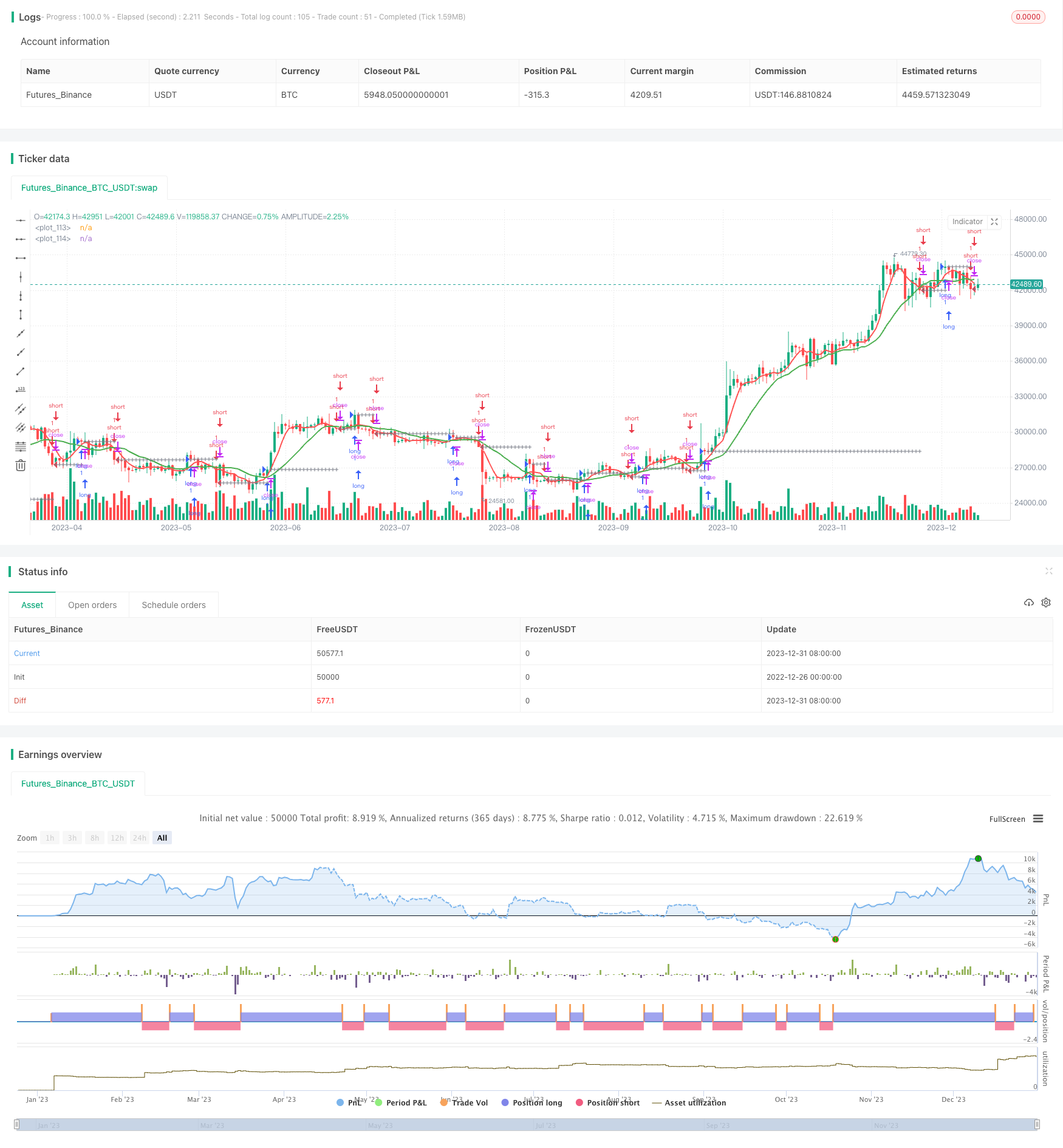
概述
该策略采用两种不同参数设置的移动平均线进行交叉操作,根据交叉信号判断趋势方向,进行开仓与平仓。策略允许选择9种不同类型的移动平均线,包括简单移动平均线(SMA)、指数移动平均线(EMA)、加权移动平均线(WMA)、阿尔莫移动平均线(ALMA)、数量价值移动平均线(VWMA) 等。策略同时设定止损位和止盈位。
策略原理
该策略的核心逻辑是比较两条移动平均线的数值,根据两条移动平均线的交叉情况判断市场趋势方向。具体来说,我们设置快线和慢线两个移动平均线。当快线上穿慢线时,认为市场进入上升趋势,做多;当快线下穿慢线时,认为市场进入下降趋势,做空。
进入仓位后,如果价格触及止损线则亏损了就退出仓位;如果价格触及止盈线则盈利达到预期就退出仓位。这样可以锁定利润,防止亏损扩大。
从代码逻辑看,策略主要分为四个部分:
计算移动平均线。根据用户选择的移动平均线类型,计算出快线和慢线的移动平均线。
生成交易信号。根据快线和慢线的交叉情况,产生做多和做空信号。
设置止损止盈位。根据入场价格和设置的止损止盈百分比,实时计算出止损线和止盈线的价格。
入场和出场。根据做多做空信号入场,根据止损止盈信号出场。
优势分析
该策略最大的优势在于可以自由选择多种类型的移动平均线。不同类型的移动平均线对价格的灵敏度不同,用户可以根据自己的需要选择合适的移动平均线。此外,可以自定义移动平均线的长度期间,实现对时间维度的优化。
另一个优势是设置了止损止盈机制。这可以有效防止亏损进一步扩大,同时锁定利润。总体而言,该策略较为灵活,可自定义程度高,适合不同需求的用户。
风险分析
该策略主要风险在于移动平均线具有滞后性。当价格突然出现大幅波动时,移动平均线无法及时响应,可能导致错过最佳入场或出场时机。这时会产生较大亏损。
另一个风险是止损止盈位置的设置。如果设置的幅度太小,有可能会被套利;如果太大,又容易导致利润锁定不够及时。所以在实盘中要根据市场情况优化止损止盈的参数。
总的来说,该策略主要依靠移动平均线判定趋势方向,所以在突发事件导致价格大幅波动时效果会打折扣。此外,参数设置也会对策略收益有较大影响。
优化方向
该策略可以从以下几个方面进行优化:
优化移动平均线的类型。根据不同市场环境和交易品种,选择更加合适的移动平均线。
优化移动平均线的参数。调整移动平均线的长度期间,使其更加符合市场特点。
添加其它指标过滤。可以加入 MACD,RSI 等其它指标,避免在没有趋势的市场中频繁交易。
优化止损止盈比例。根据历史数据计算出最优的止损止盈参数。
增加机器学习模型。使用 LSTM,随机森林等算法预测价格走势,辅助生成交易信号。
采用止损追踪算法。使止损线能够随价格走势逐步移动,减少止损被触发的概率。
总结
本策略整体来说较为简单直接,通过交叉判断趋势方向,属于典型的趋势跟随策略。优点是简单容易理解,灵活度高,可以自行选择移动平均线类型以及参数。缺点是对突发事件反应较慢,存在一定程度滞后。总体而言,该策略适合追求长线稳定收益的投资者。通过优化可以进一步提高策略稳定性和收益水平。
/*backtest
start: 2022-12-26 00:00:00
end: 2024-01-01 00:00:00
period: 1d
basePeriod: 1h
exchanges: [{"eid":"Futures_Binance","currency":"BTC_USDT"}]
*/
//@version=3
strategy("Kozlod - Yet Another Moving Average Cross Strategy", shorttitle="kozlod_yamacs", overlay = true)
//
// author: Kozlod
// date: 2018-03-06
//
////////////
// INPUTS //
////////////
ma_type = input(title = "MA Type", defval = "SMA", options = ['SMA', 'EMA', 'WMA', 'ALMA', 'VWMA', 'HMA', 'LSMA', 'SMMA', 'DEMA'])
short_ma_len = input(title = "Short MA Length", defval = 5, minval = 1)
short_ma_src = input(title = "Short MA Source", defval = close)
long_ma_len = input(title = "Long MA Length", defval = 15, minval = 2)
long_ma_src = input(title = "Long MA Source", defval = close)
alma_offset = input(title = "ALMA Offset", type = float, defval = 0.85, step = 0.01, minval = 0, maxval = 1)
alma_sigma = input(title = "ALMA Sigma", type = float, defval = 6, step = 0.01)
lsma_offset = input(title = "LSMA Offset", defval = 0, step = 1)
sl_lev_perc = input(title = "SL Level % (0 - Off)", type = float, defval = 0, minval = 0, step = 0.01)
pt_lev_perc = input(title = "PT Level % (0 - Off)", type = float, defval = 0, minval = 0, step = 0.01)
// Set initial values to 0
short_ma = 0.0
long_ma = 0.0
// Simple Moving Average (SMA)
if ma_type == 'SMA'
short_ma := sma(short_ma_src, short_ma_len)
long_ma := sma(long_ma_src, long_ma_len)
// Exponential Moving Average (EMA)
if ma_type == 'EMA'
short_ma := ema(short_ma_src, short_ma_len)
long_ma := ema(long_ma_src, long_ma_len)
// Weighted Moving Average (WMA)
if ma_type == 'WMA'
short_ma := wma(short_ma_src, short_ma_len)
long_ma := wma(long_ma_src, long_ma_len)
// Arnaud Legoux Moving Average (ALMA)
if ma_type == 'ALMA'
short_ma := alma(short_ma_src, short_ma_len, alma_offset, alma_sigma)
long_ma := alma(long_ma_src, long_ma_len, alma_offset, alma_sigma)
// Hull Moving Average (HMA)
if ma_type == 'HMA'
short_ma := wma(2*wma(short_ma_src, short_ma_len/2)-wma(short_ma_src, short_ma_len), round(sqrt(short_ma_len)))
long_ma := wma(2*wma(long_ma_src, long_ma_len /2)-wma(long_ma_src, long_ma_len), round(sqrt(long_ma_len)))
// Volume-weighted Moving Average (VWMA)
if ma_type == 'VWMA'
short_ma := vwma(short_ma_src, short_ma_len)
long_ma := vwma(long_ma_src, long_ma_len)
// Least Square Moving Average (LSMA)
if ma_type == 'LSMA'
short_ma := linreg(short_ma_src, short_ma_len, lsma_offset)
long_ma := linreg(long_ma_src, long_ma_len, lsma_offset)
// Smoothed Moving Average (SMMA)
if ma_type == 'SMMA'
short_ma := na(short_ma[1]) ? sma(short_ma_src, short_ma_len) : (short_ma[1] * (short_ma_len - 1) + short_ma_src) / short_ma_len
long_ma := na(long_ma[1]) ? sma(long_ma_src, long_ma_len) : (long_ma[1] * (long_ma_len - 1) + long_ma_src) / long_ma_len
// Double Exponential Moving Average (DEMA)
if ma_type == 'DEMA'
e1_short = ema(short_ma_src, short_ma_len)
e1_long = ema(long_ma_src, long_ma_len)
short_ma := 2 * e1_short - ema(e1_short, short_ma_len)
long_ma := 2 * e1_long - ema(e1_long, long_ma_len)
/////////////
// SIGNALS //
/////////////
long_signal = crossover( short_ma, long_ma)
short_signal = crossunder(short_ma, long_ma)
// Calculate PT/SL levels
// Initial values
last_signal = 0
prev_tr_price = 0.0
pt_level = 0.0
sl_level = 0.0
// Calculate previous trade price
prev_tr_price := long_signal[1] or short_signal[1] ? open : nz(last_signal[1]) != 0 ? prev_tr_price[1] : na
// Calculate SL/PT levels
pt_level := nz(last_signal[1]) == 1 ? prev_tr_price * (1 + pt_lev_perc / 100) : nz(last_signal[1]) == -1 ? prev_tr_price * (1 - pt_lev_perc / 100) : na
sl_level := nz(last_signal[1]) == 1 ? prev_tr_price * (1 - sl_lev_perc / 100) : nz(last_signal[1]) == -1 ? prev_tr_price * (1 + sl_lev_perc / 100) : na
// Calculate if price hit sl/pt
long_hit_pt = pt_lev_perc > 0 and nz(last_signal[1]) == 1 and close >= pt_level
long_hit_sl = sl_lev_perc > 0 and nz(last_signal[1]) == 1 and close <= sl_level
short_hit_pt = pt_lev_perc > 0 and nz(last_signal[1]) == -1 and close <= pt_level
short_hit_sl = sl_lev_perc > 0 and nz(last_signal[1]) == -1 and close >= sl_level
// What is last active trade?
last_signal := long_signal ? 1 : short_signal ? -1 : long_hit_pt or long_hit_sl or short_hit_pt or short_hit_sl ? 0 : nz(last_signal[1])
//////////////
// PLOTTING //
//////////////
// Plot MAs
plot(short_ma, color = red, linewidth = 2)
plot(long_ma, color = green, linewidth = 2)
// Plot Levels
plotshape(prev_tr_price, style = shape.cross, color = gray, location = location.absolute, size = size.small)
plotshape(sl_lev_perc > 0 ? sl_level : na, style = shape.cross, color = red, location = location.absolute, size = size.small)
plotshape(pt_lev_perc > 0 ? pt_level : na, style = shape.cross, color = green, location = location.absolute, size = size.small)
//////////////
// STRATEGY //
//////////////
strategy.entry("long", true, when = long_signal)
strategy.entry("short", false, when = short_signal)
strategy.close("long", when = long_hit_pt or long_hit_sl)
strategy.close("short", when = short_hit_pt or short_hit_sl)